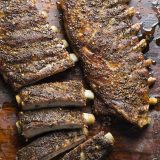To create the most tender, boldly flavored—and simplest—pork ribs, we knew we would need to find just the right cut of rich, marbled meat, as well as a potent blend of savory seasonings. But we didn’t expect that the most important ingredient would be the least flavorful—water.
We found our inspiration in a tradition-bucking recipe from Rolando Beramendi’s cookbook, “Autentico.” Though his book’s name translates as “authentic,” he jokes that his simple, flavorful approach to ribs—based on Tuscan rosticciana—actually skews from its origins.
The term rosticciana can apply to a broad array of grilled or roasted meats, but most often refers to pork ribs. Typically, the meat is seasoned with a dry rub of classic Tuscan herbs—rosemary, garlic, salt and sometimes sage, red pepper flakes or bay leaf. It can be cooked in a cast-iron pan or grilled, though some cooks insist on a brick oven. Regardless, the meat emerges aromatic and tender, with crispy edges.
Beramendi’s version uses baby back ribs, which he slices into 4-inch pieces. He rubs them with rosemary, sage, garlic and salt, then lets them rest in the refrigerator overnight before coating them with olive oil and searing them a few at a time in a cast-iron skillet. His recipe takes an unconventional turn when he then deglazes the skillet with red wine vinegar before finishing the meat in a 350°F oven while the vinegar cooks down to a sticky glaze.
At Milk Street, we loved the simplicity of the classic Tuscan flavors, but skipped the trouble of browning the ribs in favor of a longer stint in the oven, which gave us the same deliciously crispy results. We were not, however, getting the tender, moist ribs we wanted. To fix this, we swapped out baby back ribs for St. Louis spareribs. Their higher fat content helped keep them moist as they cooked.
These ribs were better, but still not quite as tender and moist as we wanted. We suspected the dry heat of the oven was at play. So we borrowed a lesson from classic American barbecue, in which meat often is kept moist by mopping it with sauces as it slowly cooks.
Mopping the meat was too much fuss, so we instead set a rimmed baking sheet of water under the ribs as they cooked. This filled the oven with steam, which kept the ribs tender and moist. Success. To further streamline, we skipped the vinegar glaze, which also allowed the flavors of the rub to shine.




